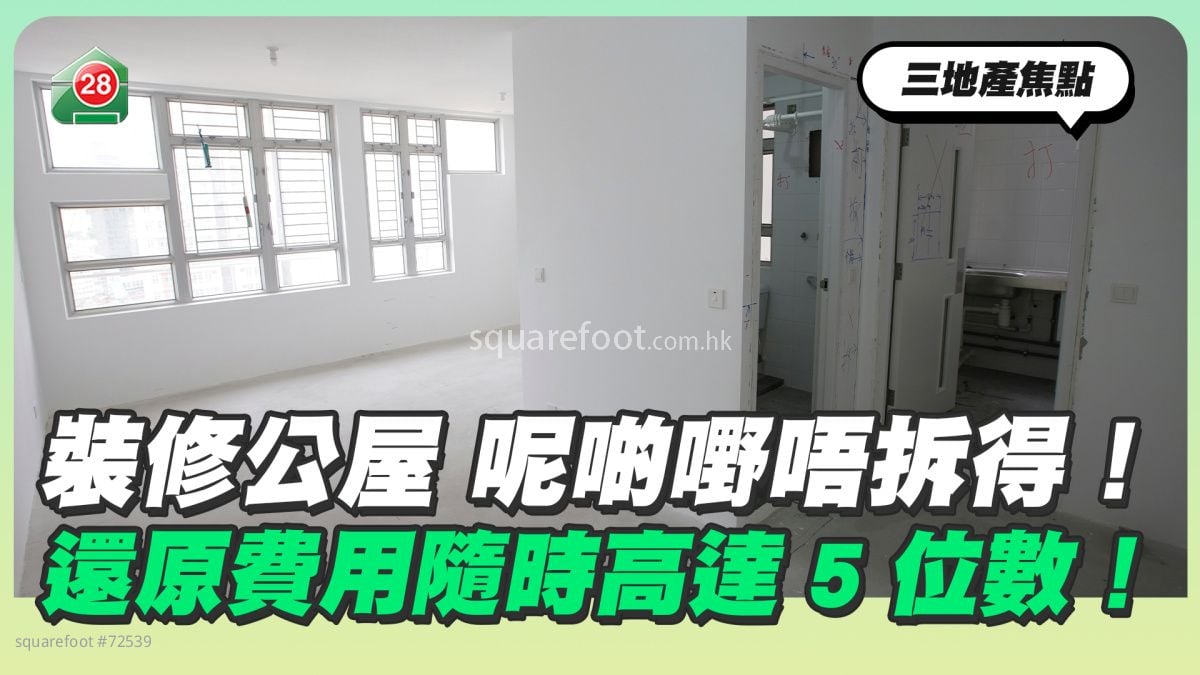- Home
- News
- Expert Blog
- Wed Property Focus
- Restoring Public Housing Units Could Cost You Five Digits!
After successfully being allocated a public housing unit, many residents choose to renovate or modify the space. However, when vacating the unit, tenants are required to revert any alterations and restore the unit to its original condition. To avoid incurring high restoration costs, what should tenants be mindful of?
According to the Housing Authority’s Home Renovation Works, the built-in fixtures of public housing units are categorised into three types: Category A, B, and C. Category A fixtures, including structural walls, main doors, kitchen doors, soundproof windows, bathroom partition walls, and electrical wiring, cannot be altered at the tenant’s expense. However, for tenants with disabilities, the Housing Authority may consider applications to modify these fixtures on a case-by-case basis.
Category B fixtures, such as bathroom, toilet, and room partition walls, washbasins, stoves, window grilles, kitchen floorings, and security gates or locks, can only be modified with prior approval from the Housing Authority. Category C fixtures, such as the color of interior wall paint, door locks, kitchen cabinets, flooring, and faucets, can be freely modified by tenants without prior approval.
It’s important to note that inspections are not limited to the time of vacating the unit. The Housing Authority may also conduct random inspections to ensure tenants comply with the guidelines. If unauthorised modifications are found, tenants must rectify or restore the changes at their own expense. Failure to address the issue within the specified timeframe may result in the issuance of an eviction notice and repossession of the unit.
When restoring a unit, tenants can either hire their own contractors or request the Housing Authority to handle the restoration, with the costs billed to the tenants. If the Housing Authority is chosen to carry out the work, they will conduct an initial inspection to estimate the restoration costs, followed by a final inspection when the unit is returned to confirm the final amount.
Not all modifications need to be removed. For example, if tenants have installed fixed fixtures or equipment such as wall-mounted kitchen cabinets or bathroom toilets in good condition, the Housing Authority generally allows these to remain for the next tenant’s use, eliminating the need for restoration.
Some tenants have shared detailed price lists of restoration costs, which are divided into two categories: "items that must be removed or restored by the Housing Authority" and "items the tenant can restore themselves." The costs vary depending on the size of the unit and the extent of modifications. If significant changes have been made, restoration costs can reach tens of thousands of dollars, making it crucial to plan renovations carefully.
One common renovation involves removing the kitchen door to create an open kitchen. However, this must be restored upon moving out. Some tenants have tried to minimise costs by sourcing discarded kitchen fireproof doors from other units or asking cleaners for replacements.
Unfortunately, this approach is no longer feasible. Since mid-2012, all public housing components, including prefabricated concrete walls, aluminum windows, wooden doors, and iron gates, have been equipped with radio-frequency identification (RFID) chips. These chips store data such as the component’s production details, model number, manufacturing location, date, and installation site. Housing Authority staff can easily detect whether a door belongs to the unit using specialised equipment, making unauthorised replacements ineffective.
Like
| Property Type | Price | Ads Period |
|---|---|---|
| For Sale Property | ||
Normal Listing Typical One | HKD:1000 (or Hsemoney:1000) | Valid:90 days |
Golden Top Listing Higher position than Top listing 2-3times better performance | HKD:3000 (or Hsemoney:3000) | Valid:60 days |
| Rental Property | ||
Normal Listing Typical One | HKD:1000 (or Hsemoney:1000) | Valid:80 days |
Golden Top Listing Higher position than Top listing 2-3times better performance | HKD:3000 (or Hsemoney:3000) | Valid:60 days |
